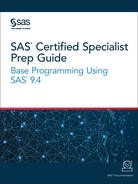Chapter Quiz
Select the best answer
for each question. Check your answers using the answer key in the
appendix.
-
Suppose you have submitted a SAS program that contains spelling errors. Which set of steps should you perform, in the order shown, to revise and resubmit the program?
-
-
Correct the errors.
-
Clear the SAS log.
-
Resubmit the program.
-
Check the Output window.
-
Check the SAS log.
-
-
-
Correct the errors.
-
Resubmit the program.
-
Check the Output window.
-
-
-
Correct the errors.
-
Clear the SAS log.
-
Resubmit the program.
-
Check the Output window.
-
-
-
Correct the errors.
-
Clear the Outputwindow.
-
Resubmit the program.
-
Check the Output window.
-
-
-
What happens if you submit the following program?
proc sort data=cert.stress out=maxrates; by maxhr; run; proc print data=maxrates label double noobs; label rechr='Recovery Heart Rate; var resthr maxhr rechr date; where toler='I' and resthr>90; sum fee; run;
-
SAS log messages indicate that the program ran successfully.
-
A log message might indicate an error in a statement that seems to be valid.
-
A SAS log message indicates that an option is not valid or not recognized.
-
A SAS log message might indicate that a quoted string has become too long or that the statement is ambiguous.
-
-
What generally happens when a syntax error is detected?
-
SAS continues processing the step.
-
SAS continues to process the step, and the SAS log displays messages about the error.
-
SAS stops processing the step in which the error occurred, and the SAS log displays messages about the error.
-
SAS stops processing the step in which the error occurred, and the Output window displays messages about the error.
-
-
A syntax error occurs during the following actions:
-
Some data values are not appropriate for the SAS statements that are specified in a program.
-
The code executes successfully, but produces incorrect results.
-
Program statements do not conform to the rules of the SAS language.
-
none of the above
-
-
How can you tell whether you have specified an invalid option in a SAS program?
-
A SAS log message indicates an error in a statement that seems to be valid.
-
A SAS log message indicates that an option is not valid or not recognized.
-
You cannot tell until you view the output from the program.
-
none of the above
-
-
Which of the following programs contains a syntax error?
-
proc sort data=cert.mysales; by region; run;
-
data=work.mysales; set cert.sales17; where sales<5000; run;
-
proc print data=work.mysales label; label region='Sales Region'; run;
-
none of the above
-
-
What are the temporary variables that can be helpful when debugging a DATA step?
-
OBS
-
_N_
-
_ERROR_
-
b and c only
-
-
When the source of the errors in the program is not apparent, which statement or statements can you use to examine errors and print messages to the log?
-
PUTLOG statement
-
PUT statement
-
VAR statement
-
a and b only
-
none of the above
-
-
What types of errors can the PUTLOG statement help you resolve?
-
syntax errors
-
semantic errors
-
logic errors
-
all of the above
-
Last updated: February 14, 2019
..................Content has been hidden....................
You can't read the all page of ebook, please click here login for view all page.
